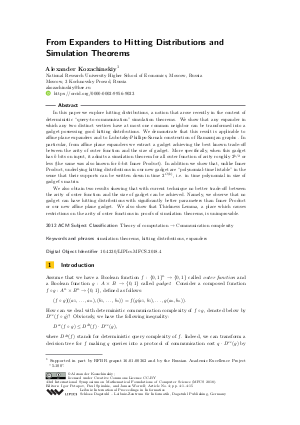From Expanders to Hitting Distributions and Simulation Theorems
Author
Alexander Kozachinskiy 
-
Part of:
Volume:
43rd International Symposium on Mathematical Foundations of Computer Science (MFCS 2018)
Part of: Series: Leibniz International Proceedings in Informatics (LIPIcs)
Part of: Conference: Mathematical Foundations of Computer Science (MFCS) - License:
 Creative Commons Attribution 3.0 Unported license
Creative Commons Attribution 3.0 Unported license
- Publication Date: 2018-08-27
File

PDF
LIPIcs.MFCS.2018.4.pdf
- Filesize: 429 kB
- 15 pages
Document Identifiers
Subject Classification
ACM Subject Classification
- Theory of computation → Communication complexity
Keywords
- simulation theorems
- hitting distributions
- expanders
Metrics
- Access Statistics
-
Total Accesses (updated on a weekly basis)
0PDF Downloads0Metadata Views
Abstract
In this paper we explore hitting distributions, a notion that arose recently in the context of deterministic "query-to-communication" simulation theorems. We show that any expander in which any two distinct vertices have at most one common neighbor can be transformed into a gadget possessing good hitting distributions. We demonstrate that this result is applicable to affine plane expanders and to Lubotzky-Phillips-Sarnak construction of Ramanujan graphs . In particular, from affine plane expanders we extract a gadget achieving the best known trade-off between the arity of outer function and the size of gadget. More specifically, when this gadget has k bits on input, it admits a simulation theorem for all outer function of arity roughly 2^(k/2) or less (the same was also known for k-bit Inner Product). In addition we show that, unlike Inner Product, underlying hitting distributions in our new gadget are "polynomial-time listable" in the sense that their supports can be written down in time 2^O(k), i.e. in time polynomial in size of gadget's matrix. We also obtain two results showing that with current technique no better trade-off between the arity of outer function and the size of gadget can be achieved. Namely, we observe that no gadget can have hitting distributions with significantly better parameters than Inner Product or our new affine plane gadget. We also show that Thickness Lemma, a place which causes restrictions on the arity of outer functions in proofs of simulation theorems, is unimprovable.
Cite As Get BibTex
Alexander Kozachinskiy. From Expanders to Hitting Distributions and Simulation Theorems. In 43rd International Symposium on Mathematical Foundations of Computer Science (MFCS 2018). Leibniz International Proceedings in Informatics (LIPIcs), Volume 117, pp. 4:1-4:15, Schloss Dagstuhl – Leibniz-Zentrum für Informatik (2018)
https://doi.org/10.4230/LIPIcs.MFCS.2018.4
BibTex
@InProceedings{kozachinskiy:LIPIcs.MFCS.2018.4,
author = {Kozachinskiy, Alexander},
title = {{From Expanders to Hitting Distributions and Simulation Theorems}},
booktitle = {43rd International Symposium on Mathematical Foundations of Computer Science (MFCS 2018)},
pages = {4:1--4:15},
series = {Leibniz International Proceedings in Informatics (LIPIcs)},
ISBN = {978-3-95977-086-6},
ISSN = {1868-8969},
year = {2018},
volume = {117},
editor = {Potapov, Igor and Spirakis, Paul and Worrell, James},
publisher = {Schloss Dagstuhl -- Leibniz-Zentrum f{\"u}r Informatik},
address = {Dagstuhl, Germany},
URL = {https://drops.dagstuhl.de/entities/document/10.4230/LIPIcs.MFCS.2018.4},
URN = {urn:nbn:de:0030-drops-95863},
doi = {10.4230/LIPIcs.MFCS.2018.4},
annote = {Keywords: simulation theorems, hitting distributions, expanders}
}
Author Details
Funding
- Kozachinskiy, Alexander: Supported in part by RFBR grapnt 16-01-00362 and by the Russian Academic Excellence Project "5-100".
References
-
Arkadev Chattopadhyay, Michal Kouckỳ, Bruno Loff, and Sagnik Mukhopadhyay. Simulation theorems via pseudorandom properties. arXiv preprint arXiv:1704.06807, 2017.

-
Susanna F de Rezende, Jakob Nordström, and Marc Vinyals. How limited interaction hinders real communication (and what it means for proof and circuit complexity). In Foundations of Computer Science (FOCS), 2016 IEEE 57th Annual Symposium on, pages 295-304. IEEE, 2016.

-
Mika Goos, Shachar Lovett, Raghu Meka, Thomas Watson, and David Zuckerman. Rectangles are nonnegative juntas. SIAM Journal on Computing, 45(5):1835-1869, 2016.

-
Mika Göös, Toniann Pitassi, and Thomas Watson. Deterministic communication vs. partition number. In Foundations of Computer Science (FOCS), 2015 IEEE 56th Annual Symposium on, pages 1077-1088. IEEE, 2015.

-
Mika Göös, Toniann Pitassi, and Thomas Watson. Query-to-communication lifting for bpp. arXiv preprint arXiv:1703.07666, 2017.

-
Hamed Hatami, Kaave Hosseini, and Shachar Lovett. Structure of protocols for xor functions. In Foundations of Computer Science (FOCS), 2016 IEEE 57th Annual Symposium on, pages 282-288. IEEE, 2016.

-
Eyal Kushilevitz and Noam Nisan. Communication Complexity. Cambridge University Press, 2006.

-
Alexander Lubotzky, Ralph Phillips, and Peter Sarnak. Ramanujan graphs. Combinatorica, 8(3):261-277, 1988.

-
Ran Raz and Pierre McKenzie. Separation of the monotone nc hierarchy. In Foundations of Computer Science, 1997. Proceedings., 38th Annual Symposium on, pages 234-243. IEEE, 1997.

-
Omer Reingold, Salil Vadhan, and Avi Wigderson. Entropy waves, the zig-zag graph product, and new constant-degree expanders. Annals of mathematics, pages 157-187, 2002.

-
Salil P Vadhan et al. Pseudorandomness. Foundations and Trendsregistered in Theoretical Computer Science, 7(1-3):1-336, 2012.

-
Xiaodi Wu, Penghui Yao, and Henry Yuen. Raz-mckenzie simulation with the inner product gadget. In Electronic Colloquium on Computational Complexity (ECCC), 2017.

